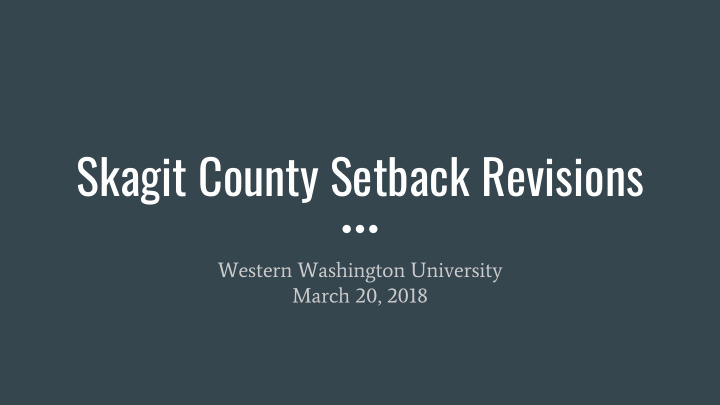



Skagit County Setback Revisions Western Washington University March 20, 2018
Skagit County Code Revisions: Summary ● Researched other counties’ setback codes and requirements to generate revised setback requirements for Skagit County Code (SCC) Compared language, format, and measurement requirements to SCC ○ ○ Analyzed for clarity, appeal, comprehension ○ Identified the use of graphics, tables, brochures, and other tools 2
Skagit County Code Revisions: Purpose ● Revise Skagit County Code (SCC) setback requirements to: ○ Minimize complexity of SCC setback definitions, layout, comprehensiveness, references ○ Reduce setback variances requests as a result of complicated SCC ○ Ensure requirements meet goals of Skagit County's Comprehensive Plan ○ Revise setbacks to identify minimum standards for a set of zones and roadway types 3
Skagit County Code Revisions: Background ● Met with Skagit County planning staff ○ January: initial project orientation ○ February: planners from Skagit County came to WWU to see interim findings & give feedback ● Feedback from planners used to further develop revisions for the setback requirements 4
Proposal I: Setbacks by Road Type 5
Whatcom County Code Setbacks Organized by Road Types: Comparisons ● Compared Skagit to 6 other counties ○ Whatcom: aesthetic appeal ○ Organized by road type ● Most counties had lower setback numbers than Skagit ● Whatcom County had 7 total variance requests in 2016. 6
Setbacks Organized by Road Types: Proposed Changes ● Revise Dimensional Standards Table to organize setbacks by road type ● Decrease the minimum setback from 25ft to 20ft in the zones of: ○ Rural Intermediate (RI) ○ Rural Village Residential (RVR) ○ Rural Reserve (RRv) ○ Where access points of parcel is off a local access road ● Decrease the minimum setbacks in the Secondary Forest- NRLs from 100ft to 50ft ● To avoid using "see code" in table, state the 200-foot maximum setback requirement for the Ag-NRL in section 14.16.400 ○ Replace the word "same" with setback numbers 7
Setbacks Organized by Road Type: Justifications ● Organize by road type to simplify the table, making it more user-friendly ● Change Skagit County front setback from 25ft to 20ft on parcels off local access roads ○ Matches other counties ● Standardize Skagit County’s setback requirements for the Secondary Forest-NRLs to match the 50-foot minimum setbacks of the Rural Resource-NRLs ● Remove the “see code” from Ag-NRL and use the minimum setback ○ Simplifies the table ● State the setback requirements instead of using the word "same" ○ Less confusing for the public 8
Setbacks Organized by Road Type: Table ● Road Types obtained from Skagit’s Comprehensive Plan (Section 8: Transportation) ● Includes proposed setback revisions 9
Proposal II: Setback Requirements Revisions 10
Setback Requirements Revision: Outline ● Purpose ● Definition ● Use of Setback Area ● Measurements ● Special Setback Requirements ● Reduction of Setbacks ● Overlays 11
Setback Requirements Revision: Purpose ● Purpose subsection would: ○ Create uniformity within Skagit County Code (almost all other sections have Purpose statements) ○ Eliminate need to outline purpose on DSW ○ Outline the rest of the Setback Requirements Code (14.16.810) 12
Setback Requirements Revision: Definition ● Keep it short ● Include “minimum required distance” ● Other counties suffice with one or two examples of a defining line 13
Setback Requirements Revision: Applicability ● Organizes all separate uses within one subsection ● Negate need to include additional parameters from Setback Definition 14
Setback Requirements Revision: Measurements ● Revised definition for setback front, rear, and side ● Revised Vision Clearance ● Graphics ○ Vision Clearance ○ Lot Type Examples 15
Setback Requirements Revision: Measurement Visuals Lot type examples taken from the Skagit County Dimensional Standards Worksheet (DSW). Example for split lots added. 16
Setback Requirements Revision: Special Setback Requirements - Split lots ● Purpose: ○ Allow property owners to build accessory structures on smaller division of property ○ Reduce the need for variances ● Front Setback: Average of existing neighboring structures ● Side and rear: 3 feet 17
Setback Requirements Revision: Variances and Easements ● Propose moving Easements to their own section within SCC ○ Keeps Setback Requirements clean, concise, and pertinent ○ Simplify Easement language, similar to DSW 18
Setback Requirements Revision: Overlays ● Create distinct subsection within Setback Requirements for Overlays ○ Currently contains Ag-NRLs, but not Guemes Island or Airport Environs ○ Negates need to include Overlays within a DSW ○ Strengthens cross-referencing within the SCC itself, with navigational hyperlinks 19
Proposal III: Dimensional Standards Worksheet Revision 20
Dimensional Standards Worksheet (DSW): Revisions ● DSW is too long and cumbersome ● Proposed code revision eliminates the need for much of the DSW ● Revised DSW: Multiple 1-2 page handouts by development type ○ User-friendly ○ Straight-forward 21
Proposed Dimensional Standards Worksheet: Outline ● Purpose of setbacks ● How to find your setback ○ Locate your parcel ○ Identify road class ○ Determine your setbacks ● Other considerations ○ ex. accessory structures and variances ● Lot type examples ● Setback requirements table for type of development 22
Conclusion Deliverables: ● Dimensional Standards Table by road type ● Revised Setback Requirements code and definition ● Dimensional Standards Worksheet by development type 23
References Clark County. (2017). Definitions Chapter. 30.08. Retrieved from http://www.clarkcountynv.gov/comprehensive-planning/zoning/Documents/3008.pdf Clark County. (2018). Unified Development Code, Title 40. Retrieved from https://www.clark.wa.gov/community-development/unified-development-code-title-40 Island County. (2017). Island County Code. Retrieved from https://library.municode.com/wa/island_county/codes/code_of_ordinances Jefferson County. (2017). Brochure #12: Residential Setbacks for Buildings in Rural Residential Zoning Without Critical Area Consideration. Retrieved from http://www.co.jefferson.wa.us/DocumentCenter/Home/View/618 King County. (1993). Setback definition, 10870 § 254. King County Municipal code Title 21 Zoning. Retreived from, https://www.kingcounty.gov/council/legislation/kc_code/24_30_Title_21A.aspx. Kitsap County. (2017). Kitsap County Brochure, #47: Residential Setbacks. Retrieved from https://spf.kitsapgov.com/dcd/FormsandBrochures/Residential%20Setbacks.pdf Kitsap County. (2017). Title 17 Zoning. Retrieved from http://www.codepublishing.com/WA/KitsapCounty/#!/Kitsap17/Kitsap17.html Skagit County. (2016). Definitions Chapter 14.04.020. Retrieved from http://www.codepublishing.com/WA/SkagitCounty/#!/SkagitCounty14/SkagitCounty1404.html#14.04 Skagit County. (2016). Skagit County Comprehensive Plan, p.14. Retrieved from https://www.skagitcounty.net/PlanningAndPermit/Documents/CompPlan2016/comp-plan-2016-adopted-text-only.pdf Skagit County. (2016). Unified Development Code, Title 14. Retrieved from http://www.codepublishing.com/WA/SkagitCounty/#!/html/SkagitCounty14/SkagitCounty14.html Snohomish County. (2018). Purpose and Establishment of Zones. 30.21.020. Retrieved from https://snohomish.county.codes/SCC/30.21.020 Whatcom County. (2018). Setback Line Definition. 20.97.362. Retrieved from http://www.codepublishing.com/WA/WhatcomCounty/html/WhatcomCounty20/WhatcomCounty2097.html#20.97.362 24
Recommend
More recommend